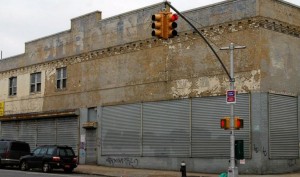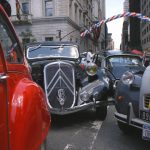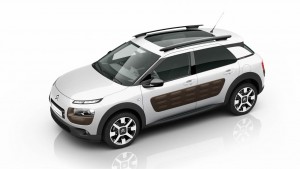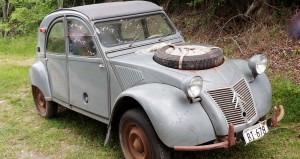“Weißt Du noch, Citroën? Die bauten Autos, die auf drei Rädern fuhren.” Die Augen des chinesischen Lagerleiters leuchten. Als ob er die Informationen seit Jahren wie ein kleines Geheimnis hütet…
Es ist Freitagmorgen an der Ecke 3rd Avenue und 7th Street im New Yorker Stadtteil Brooklyn, genauer gesagt im Viertel Gowanus. Die Farbe ist verwaschen. Aber wir können immer noch Spuren erkennen: die weißen Buchstaben auf der Vorderseite der riesigen Lagerhalle, der Name “Citroen” flankiert von zwei Doppelwinkeln, dem legendären Markenlogo. Jetzt ist die Lagerfläche mit Sofas, Tischen und anderen Möbeln vollgestellt, doch in den 1960er und 1970er Jahren war hier eine mehr als nur eine Lagerhalle: ein Reparaturbetrieb und Vertrieb des französischen Autoherstellers. Im Inneren des Gebäudes gibt es noch einige wenige Anzeichen dieser längst vergangenen Ära. Beginnend mit den Stahlträgern, die verwendet werden, um die Chassis und Motoren über Laufkatzen und Deckenkräne zu transportieren. “Und dann war da noch ein riesiger unterirdischer Öltank, wir mit Zement auffüllen mussten”, sagte Steven Cheu Ngai, Chef der Möbel-Import-Export-Firma, die seit 1991 in den Räumlichkeiten ihren Sitz hat.
In dieses Lager ging Carter Willey, ehemaliger Mitarbeiter eines Citroën-Autohauses in der Bronx, in den 60er Jahren “rund drei- bis viermal” pro Jahr. Er war auf der Suche nach Teilen oder ganzen Autos für die Kunden. “Es gab viele Menschen, die hier arbeiteten,” erinnert er sich. “In diesem Lager wurde die zentrale Koordination der Einfuhr von Teilen für New York und die gesamte Ostküste abgewickelt.”
In den Vereinigten Staaten begann Citroën ab 1938 mit der Vermarktung seines legendären Modells “Traction Avant”. Dann kam die legendäre DS, 2CV und der Ami6 (unter anderem). Laut Automobiles Citroën France wurden mehr als 7.000 Autos auf US-Boden zwischen 1970 und 1976 verkauft. “Brooklyn ist der bevölkerungsreichste Stadtteil von New York, und damit ein wichtiger Stützpunkt für Citroën. Wie auch Manhattan”, wo das Unternehmen seinen Hauptsitz für die Ostküste hatte (die Zentrale für den Vertrieb an der Westküste war in Los Angeles beheimatet). “Und es gab einen Showroom auf der 300 Park Avenue”, sagte Howie Seligmann, der Gründer des “New York Citroën und Velosolex Clubs” und einer der “Citroënisten” der ersten Stunde.
Die Nachfrage war zu gering, bei der Fertigung gab es Probleme, das Vertriebsnetz war nicht ausreichend erweitert worden, die nationalen Vorschriften zu restriktiv: Citroën stellte 1977 die Aktivitäten in den USA ein. “Für die Amerikaner war Citroën im Ansehen weniger wert als ein Jaguar, aber mehr als ein Rolls Royce. Das war ein zu exklusiver Markt. Der Vertrieb konnte nie wirklich eine schwarze Null erzielen” erzählt Howie Seligmann, und Carter Willey ergänzt: “Man sollte bei der Definition des Begriffs “Frankophobie” in Wikipedia nachschlagen, um den Misserfolg von Citroën in den Vereinigten Staaten zu erklären. Es gab aber auch andere Gründe: Citroën Händler waren unterfinanziert, ihre Filialen zu klein. Sie konnten die Begeisterung für die französischen Fahrzeuge nicht ausreichend auf das amerikanische Klientel überspringen lassen. Die Autos waren zu selten und letztendlich zu teuer.”
Die Brooklyn-Lager an der Third Avenue gingen in andere Hände über. “An einen Hersteller von Kfz-Teilen” glaubt Cheu Ngai zu wissen. Heute wird er einen zweiten Tod von Citroën begleiten: die letzten Spuren der Marke an der Backsteinfassade werden nunmehr für immer verschwinden. Der “Citroen”-Schriftzug und die Winkel werden mit grauer witterungsfester Fassadenfarbe überdeckt, um der drohenden Erosion etwas Einhalt zu gebieten. “Es wird innerhalb einer Woche erledigt sein, natürlich abhängig vom Wetter”, sagt der Besitzer. Und als müsste er sich für das Auslöschen eines Stück Geschichte entschuldigen, ergänzt er: “Wir tun es für die Gesellschaft. Die Gegend hier ändert sich sehr schnell, und wir müssen die Gebäude instandhalten. Wir können es uns nicht leisten, jeden Ziegel einzeln zu ersetzen. Wenn ich es nicht tue, wird jemand anderes es später tun.”
“Es ist immer traurig, aber zugleich bedeutet es auch einen neuen Anfang,” stellt Howie Seligmann fest. “Wo Citroën verschwunden ist, kommt vielleicht eine andere Marke wieder empor. Kurz gesagt, das ist die Geschichte von New York…”
Photo: Maurin Picard, Autor: Alexis Buisson, deutsche Übersetzung: Amicale Citroën

—–
in Brooklyn New York, the last traces of Citroën vanish
“Do you remember, Citroën? They built cars that drove on three wheels.” The eyes of the Chinese warehouse manager glow. As if he guards for years as a little secret this information.
It is Friday morning at the corner of 3rd Avenue and 7th Street in Brooklyn, the Gowanus neighborhood. The color is washed out. But we can still see traces of white letters on the front of the enormous warehouse, the name “Citroen” flanked by the two “double-chevrons”, the legendary brand logo. Now the storage area is filled with sofas, tables and other furniture, but in the 1960s and 1970s there was a warehouse, a repair shop and distribution of the French car manufacturer. Inside the building there are some signs that remained from that era. Starting with the steel girders to be used to transport the chassis and engines via trolleys and overhead cranes. “And then there was a huge underground oil tank, we had to fill with cement,” said Steven Cheu Ngai, head of the furniture import-export company sitting in the premises since 1991.
Carter Willey, a former employee of a Citroen car dealership in the Bronx in the 60s, went to this site “about three or four times” per year. He was looking for parts or whole cars for the customers. “There were many people who worked here,” he recalls. “In this camp, the central coordination of imports of parts of New York and the entire East Coast was settled.”
In the United States Citroën began marketing its legendary model “Traction Avant” from 1938 onwards. Then the legendary DS, 2CV and Ami6 were sold here (among other models). According to Citroën France, more than 7,000 cars were sold on U.S. ground between 1970 and 1976. “Brooklyn is the most populous area of New York, thus it was an important market for Citroën. Like Manhattan”, where the company had its headquarters on the East Coast (the headquarters for activities on the West Coast was located in Los Angeles). “And there was a showroom at 300 Park Avenue,” said Howie Seligman, the founder of Citroën New York and Vélosolex club and one of the “Citroënists” of the first hour.
The demand was low, there were problems in the production, the distribution network was not sufficiently expanded, the national laws too restrictive: 1977 Citroën stopped their activities in the United States. “…For Americans, Citroën’s reputation was worth less than a Jaguar, but more than a Rolls Royce. It was too exclusive for market, the sales figures could never really get in the black,” says Howie Seligmann, and Carter Willey adds: “One should Look at the definition of “Franko phobia” in Wikipedia to explain the failure of Citroën in the United States, there were also other reasons. Citroën dealers were under-funded, its branches too small and could not sufficiently transport their enthusiasm for the French vehicles to the potential American clientele. The cars were rare and ultimately too expensive.”
The Brooklyn warehouse on Third Avenue passed into other hands. “At a manufacturer of automotive parts” believes Cheu Ngai to know. Today, he will face a second death of Citroën: the last traces of the mark on the brick facade will now disappear forever. The “Citroen” logo and the angles are covered with gray weather-resistant exterior paint to curb the threat of erosion somewhat halting. “It will be done within a week, of course, dependent on the weather,” says the owner. And when he had to apologize for the extinction of a piece of history, he adds: “We do it for the society. Area here changes very quickly, and we must maintain the building., We can not afford to replace each tile individually. If I do not, someone else will do it later.”
“It is always sad, but at the same time it also means a new beginning,” Howie Seligmann is sure. “Where Citroën has disappeared, maybe another brand comes up again. In a nutshell, this is the story of New York …”
Photo: Maurin Picard, Author: Alexis Buisson, english translation: Amicale Citroën
—–
À Brooklyn, un morceau de Citroën disparait
Un article de “French Morning”, New York, nous avons trouvé sur le web:
“…Demande trop restreinte, problèmes de fabrication, réseau de vente pas assez étendu, règlementation trop contraignante: Citroën USA a éteint le moteur en 1977 et l’activité de l’atelier a décliné. “Pour les Américains, les Citroën étaient moins qu’une jaguar, plus qu’une Rolls Royce. C’était un marché exclusif. Leurs ventes ne leur ont pas permis d’atteindre l’équilibre“, poursuit M. Seligmann. “Vous devriez regarder la définition de francophobie dans Wikipédia, suggère quant à lui Carter Willey pour expliquer l’échec de Citroën aux Etats-Unis. Il y avait aussi d’autres raisons: les concessionnaires Citroën étaient sous financés, et leurs entreprises petites et enthousiastes. Les voitures étaient étranges et coûteuses“.
L’entrepôt de Brooklyn est passé entre d’autres mains. “Un fabricant de pièces détachées pour automobiles” croit savoir Steven Cheu Ngai. Aujourd’hui, il s’apprête à connaitre une deuxième mort: la peinture sur sa façade de brique est sur le point de disparaitre pour de bon. Le “CITROEN” et ses chevrons seront recouverts par une peinture grise censée empêcher la chute de briques et l’érosion. “Ça sera fait dans la semaine, en fonction de la météo”, précise le propriétaire. Conscient d’effacer un morceau d’histoire, il s’excuse. “Nous le faisons pour la communauté. Le quartier ici change très rapidement, nous devons réparer le bâtiment, il ne l’a jamais été. Et cela coûterait trop cher de remplacer chaque brique. Si je ne le fais pas, quelqu’un d’autre le fera plus tard“.
“C’est toujours triste, mais en même temps, cela signifie aussi un nouveau départ, relativise Howie Seligmann. Là où Citroën a échoué, peut-être qu’un autre réussira“, Bref, toute l’histoire de New York…”
Photo: Maurin Picard, Auteur: Alexis Buisson










